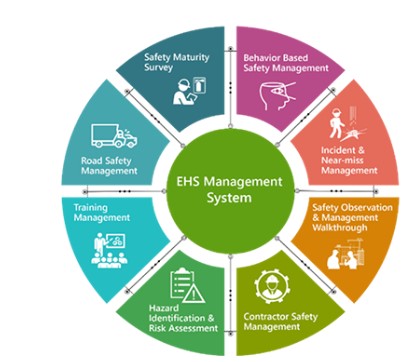Understanding Environmental Hazards in the Workplace
When we talk about HSE, the “E” Environment Often Gets Overlooked
When discussing Health, Safety, and Environment (HSE), the “E”—Environment—often gets overshadowed by more immediate concerns like worker injuries and safety protocols. However, managing environmental hazards is just as critical as protecting the people in your workplace. These environmental risks don’t just harm the planet—they also pose significant threats to employee health and the long-term sustainability of your operations. Whether it’s toxic waste, poor air quality, or improper waste disposal, the impact of environmental hazards is far-reaching.
In this blog, we’ll explore the common environmental hazards in the workplace, how they affect both the environment and employees, and what proactive steps you can take to reduce these risks and stay compliant with environmental regulations.
What Are Environmental Hazards?
Environmental hazards are elements in the workplace that pose a risk to people’s health, safety, or the surrounding ecosystem. These hazards may arise from workplace activities, the materials used, or the processes employed in daily operations. Common environmental hazards in the workplace include:
1. Chemical Spills and Leaks
Spills or leaks of toxic chemicals (e.g., solvents, cleaning agents, or industrial chemicals) can contaminate the environment and lead to severe health risks for workers.
Example: A spill of a toxic chemical such as hydrochloric acid in a laboratory or factory setting can not only damage equipment but also result in chemical burns or respiratory problems for workers exposed to the vapors.
2. Airborne Pollutants
Pollutants such as dust, smoke, fumes, and gases can compromise indoor air quality, leading to respiratory issues, lung diseases, or even cancer in the long term.
Example: Construction sites produce high amounts of dust, while factories and manufacturing plants might emit smoke or fumes that are harmful to workers.
3. Noise Pollution from Machinery
Excessive noise from machinery or industrial equipment can cause Noise-Induced Hearing Loss (NIHL), and interfere with workers’ ability to concentrate, leading to potential accidents.
Example: Factories and construction sites where loud equipment operates continuously expose workers to dangerous decibel levels, increasing the risk of hearing damage.
4. Fire Hazards Due to Poor Waste Handling
Improper storage or handling of flammable materials (like oils, chemicals, or waste) increases the risk of fire.
Example: Improperly disposed of flammable waste can ignite spontaneously or during the course of operations, leading to devastating fires in industrial settings.
5. Improper Waste Disposal
Improper disposal of hazardous materials can lead to soil contamination, water pollution, and other harmful environmental impacts.
Example: Dumping industrial waste into rivers or improperly discarding chemical containers can pollute the water and soil, impacting both the ecosystem and public health.
Common Industries Affected
Certain industries are more prone to environmental hazards due to the nature of their operations. These sectors face unique challenges in managing environmental risks:
1. Manufacturing
Chemical use and emissions from industrial machinery can result in air, soil, and water contamination.
Examples: Chemical plants, factories that use solvents, or production lines that produce airborne pollutants.
2. Construction
The use of asbestos, exposure to dust, and fuel leaks from machinery are common environmental hazards in the construction industry.
Examples: Dust from demolition or construction work, asbestos exposure in older buildings, and fuel spills from heavy machinery.
3. Healthcare
Hazardous medical waste, including infectious materials and chemicals, requires special disposal to avoid environmental contamination.
Examples: Improper disposal of needles, infectious waste, and pharmaceutical waste in hospitals and clinics.
4. Mining & Oil
Land and water pollution from mining operations and oil drilling can severely affect surrounding ecosystems, creating long-lasting environmental damage.
Examples: Oil spills, chemical runoff into nearby bodies of water, and deforestation due to mining activities.
How to Reduce Environmental Hazards
Addressing and managing environmental risks is crucial for protecting both workers and the environment. Here are some effective strategies to reduce environmental hazards in the workplace:
1. Conduct Environmental Risk Assessments
Conduct a thorough environmental risk assessment to identify and prioritize risks. This assessment will help you understand the potential impact of various processes on the air, water, and soil, allowing you to take corrective actions.
Risk assessment tools: Use methods such as HAZOP (Hazard and Operability Study) or HIRA (Hazard Identification and Risk Assessment) to systematically evaluate environmental risks.
2. Implement a Waste Management Plan
Develop and implement an effective waste management plan that outlines procedures for sorting, recycling, and proper disposal of both hazardous and non-hazardous materials.
Best practices:
Use color-coded bins and clear signage to help employees separate waste.
Ensure hazardous waste is disposed of in compliance with local and international environmental laws.
3. Provide Training on Spill Response and Disposal
Equip employees with the knowledge and tools to handle chemical spills, chemical contact, and emergency responses.
Spill response training should include steps on containment, clean-up, and disposal of hazardous materials safely.
4. Use Eco-Friendly Alternatives
Transition to biodegradable or less toxic materials where possible to minimize the environmental footprint of operations.
Example: Replace harmful chemicals with eco-friendly cleaning agents or non-toxic paints in manufacturing processes.
5. Track and Report Environmental Impact
Regularly monitor environmental metrics like emissions, waste volumes, and resource use to stay compliant with regulatory standards and make improvements.
Set annual goals to reduce carbon footprint, water usage, and waste production.
Legal and Ethical Responsibility
Environmental regulations are becoming increasingly stringent worldwide, and organizations must comply with these standards to avoid serious legal consequences. Failure to adhere to environmental laws can result in:
Hefty fines and penalties for non-compliance.
Shutdowns of operations or forced modifications to existing processes.
Reputational damage from negative media coverage.
However, beyond compliance, taking care of the environment is the right thing to do. Ethical business practices focus on sustainability, minimizing environmental impact, and contributing to the long-term well-being of the planet and community.
Conclusion
Environmental hazards in the workplace pose serious risks not only to employee health but also to the surrounding ecosystem. By understanding and addressing these hazards—through risk assessments, sustainable practices, and waste management plans—organizations can protect both workers and the environment.
A commitment to environmental safety enhances not only legal compliance but also a company’s reputation, employee well-being, and operational efficiency. Proactively managing environmental risks helps create a sustainable and responsible workplace that benefits everyone.


